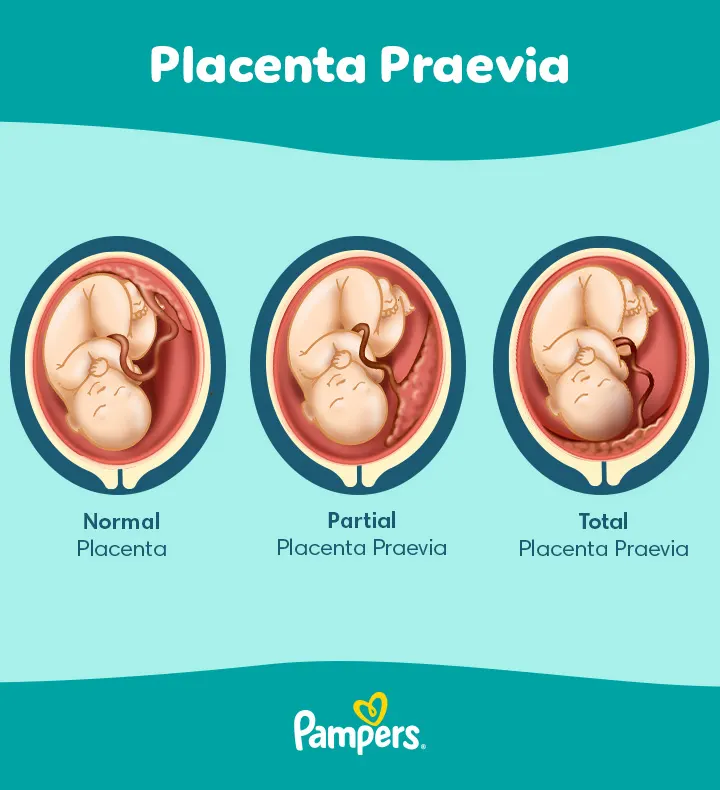Placenta Previa: What It Is and Symptoms
Placenta previa is a condition that affects a small percentage of pregnant individuals. It occurs when the placenta grows in an abnormal position, covering the cervix, which can lead to complications during pregnancy and delivery. The placenta plays a crucial role in supplying nutrients and oxygen to the fetus while removing waste. Continue reading to learn more about placenta previa, its causes, symptoms, and the best methods for treatment and management.
What Is a Placenta and What’s Its Role in Pregnancy?
The placenta is a vital organ that develops during pregnancy, acting as a lifeline between you and your baby. So, where’s the placenta located? It attaches to the wall of the uterus, usually at the top or side, and connects to the baby via the umbilical cord.
The primary role of the placenta is to provide your growing baby with oxygen and nutrients. Additionally, it
helps remove waste products from the baby’s bloodstream. The placenta also produces important hormones to support the pregnancy and protects the baby by acting as a barrier against some harmful substances. After birth, the placenta is expelled from the body in a process called the afterbirth.
What Is Placenta Previa and How Does it Affect Pregnancy?
In most pregnancies, the placenta attaches itself to the side or top part of the uterus. Placenta previa is a rare condition in which the placenta is low-lying in the uterus and partially or completely covers the cervix. This can block the exit when the baby is leaving the uterus and cause severe bleeding upon delivery or even during pregnancy.
Many pregnant people who are diagnosed with placenta previa early in their pregnancy find that the condition resolves itself, especially in the case of marginal placenta previa, when the cervix is only partially covered by the placenta. But in the case of complete placenta previa, which is when the placenta completely covers the cervix, it’s unlikely to resolve itself before birth.
Placenta Previa Symptoms
With placenta previa, you may experience no signs or symptoms. The main sign might be painless bleeding from the vagina that commonly occurs in the second half of the pregnancy. Call your healthcare provider if you experience any vaginal bleeding in your second or third trimester or if you experience contractions. Seek emergency medical care if bleeding is severe.
What Causes Placenta Previa?
The causes of placenta previa are not known, but some possible risk factors include if
you’ve had a baby before
you’ve had surgery or another procedure that may have left a scar on your uterus, such as a cesarean section or uterine fibroid removal
you’ve had placenta previa before
you’re carrying twins, triplets, or other multiples
you’re older than 35
you smoke.
Risks and Complications Associated with Placenta Previa
Your healthcare provider must monitor both you and your baby to reduce the risk of complications. The possible placenta previa risks are:
Severe bleeding. This can occur during labour, during delivery, or after delivery.
Preterm birth. Bleeding may cause you to undergo an emergency cesarean section, even before your baby is full term.
How Can I Find Out if I Have Placenta Previa?
Should you have placenta previa, it will show up during your usual prenatal checkups or a second-trimester ultrasound. To be certain or to get a more thorough diagnosis, your provider may also need to do a transvaginal ultrasound, using a wand-like device placed inside the vagina.
Should your provider suspect or notice any signs of placenta previa, they may do additional ultrasounds to determine the precise location of the placenta, whether it is low-lying, and assess whether it can resolve itself during your pregnancy.
However, if you experience any heavy bleeding during your pregnancy, see your healthcare provider or go to the hospital immediately.
How Common Is Placenta Previa and Who Is at Risk?
Placenta previa is relatively rare, affecting around 1 in 200 pregnancies. As we mentioned above, some risk factors may include a history of placenta previa in a previous pregnancy, having had a baby before, prior surgeries or procedures that may have left a scar on your uterus (cesarean section or uterine fibroid removal), being pregnancy with multiple babies, and smoking or drug use.
Treatment Options for Placenta Previa?
If you do have placenta previa, the severity of the condition may depend on factors such as your and your baby’s health; how far along your pregnancy is; the position of the placenta; and to what extent it actually covers the cervix. Your healthcare provider will monitor whether the placenta previa resolves itself, which is common by weeks 32 to 35 of pregnancy. But if it doesn’t, they will aim to get you as close to full term as possible.
If you’re late into your pregnancy and you still have placenta previa, a c-section may be required. If your placenta previa is low-lying but doesn’t cover the cervix, you may be able to have a vaginal birth, but talk this through with your healthcare provider.
In any case, the most important thing you need to do is take care of yourself, rest as much as possible, and avoid any activities that may trigger bleeding, like exercise.
There is no need to worry about placenta previa. It’s a rare condition, and even if your healthcare provider diagnoses you with it or you have symptoms of placenta previa, there is a good chance it will go away by itself. And if it doesn’t resolve itself, your provider can manage the condition so both you and your baby are safe and healthy.
Can I Naturally Move the Placenta Up? Understanding the Options
It is not possible to naturally move the placenta up during pregnancy. However, if your placenta is low-lying in the early stages of pregnancy, such as in cases of placenta previa, it may move upward on its own as the uterus expands and no treatment will be needed. This happens in most cases by the third trimester, as the uterus grows and pulls the placenta away from the cervix.
There are no exercises or lifestyle changes that can manually move the placenta. Regular monitoring through ultrasounds is typically recommended to check the placenta's position as the pregnancy progresses.
FAQS AT A GLANCE
Placenta previa may cause severe bleeding that puts you and your baby at risk, which is why you may need an immediate C-section. If your baby is born early due to placenta previa, there are additional problems and risks associated with preterm birth. Your healthcare team will provide the proper support and care you need along the way.
The Bottom Line
Placenta previa is a condition that requires careful monitoring during pregnancy but often resolves on its own as the uterus expands. Regular prenatal care, including ultrasounds, is essential to track the position of the placenta and ensure the safety of both you and your baby. In cases where the placenta remains low-lying later in pregnancy, your healthcare provider will recommend the best course of action, which may include a planned cesarean delivery to avoid complications. Staying informed and working closely with your healthcare team can help manage placenta previa and support a healthy pregnancy outcome.
How We Wrote This Article The information in this article is based on expert advice found in trusted medical and government sources, such as the American Academy of Pediatrics and the American College of Obstetricians and Gynecologists. You can find a full list of sources used for this article below. The content on this page should not replace professional medical advice. Always consult medical professionals for full diagnosis and treatment.
Join Pampers Club and get:





